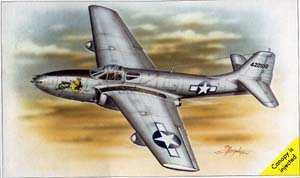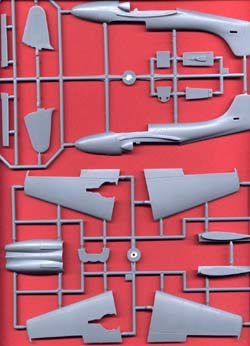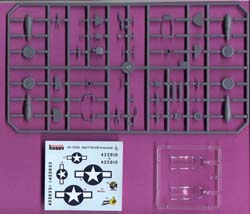Special Hobby 1/72 Bell P-59 A/B Airacomet |  | History The list of national firsts in Turbo-jet (properly gas turbine, reaction propulsion engines) flight , it is generally agreed, looks like this: -
December 10, 1910: Coanda, at Issy-les Moulineaux, flown by Henri Coanda of Romania. Not strictly a "Turbo-jet" as it used a reciprocating engine to drive the compressor. It is generally listed as the first step toward "jet" propulsion of airplanes. -
August 27, 1939: Heinkel He.178, at Marienehe, flown by Erich Warsitz. -
August 27, 1940: Caproni-Campini N.1, at Linate, flown by Mario De Bernardi. Again, not strictly a "Turbo-jet" as a reciprocating engine drove a ducted fan ahead of the"burner". It deserves inclusion here as a stepping stone to further jet flight. -
May 15, 1941: Gloster E.28/39 "Pioneer", at Cranwell, flown by Gerry Sayer. -
October 1, 1942: Bell XP-59A "Airacomet", at Rogers Dry Lake, flown by Bob Stanley. -
August 7, 1945: Nakajima "Kikka", at Kisarazu, flown by Susumu Takaoka. First jet flights of indigenous designs in other nations - France, The Soviet Union, Argentina, etc. followed WWII but these first six were the most important milestones. The initial German, British and American jet projects were all kept quite secret until the Germans launched the Messerchmitt Me.262 "Schwalbe" into the formations of Boeing B-17s in October 1944 - then the race was on in earnest. Bell's jet project was launched by USAF Major General Henry H. Arnold in September 1941. 13 months later the first XP-59A, flown by Bell's Chief Test Pilot Robert Stanley, made its first flight. The engines used in early XP-59A flights were GE model 1-As; essentially license built British Whittle engines of about 1,400 pounds static thrust. Three XP-59As were followed by 13 YP-59A service test airplanes, 20 P-59A and 30 P-59B production models; the last being delivered in May 1945. All P-59s were retired by the end of 1949. One YP-59A was traded with the Brits for a Gloster Meteor in late 1943. The Meteor was the only Allied jet fighter to see combat in WWII. Two YPs went to the US Navy and two to NACA. Later the USN also got three P-59B's and NACA got one. Because Bell's engineers were dealing with hosts of unknowns, their design was very conservative resulting in a heavy, underpowered, airplane with a light wing loading. As a consequence it was not on par with its contemporary reciprocating engined fighter brethren. It never saw combat. Its great significance is the fact that it was America's first step into the jet age. The P-59, particularly P-59B-1-BE, s/n 44-22656, is especially significant to me as it was the jet with which I had my first hands-on experience in 1953 whilst an undergraduate at Purdue University. So I naturally have a soft spot in my head for the type, of which there are only six survivors: -
XP-59A, 42-108784, the first P-59, in the NASM at Washington, D.C. -
YP-59A, 42-108777, in Ed Maloney's Planes Of Fame Museum at Chino, California. This is being restored to airworthiness. -
P-59A-1-BE, 44-22614, at March Air Force Base, California. -
P-59B-1-BE, 44-22656, in the Harold Warp Pioneer Village Museum at Minden, Nebraska; this is my, the ex-Purdue, airplane. -
P-59B-1-BE, 44-22633, at Edwards Air Force Base, California; this is the "Reluctant Robot", one of the two decal markings provided in the kit. This is also the only P-59 to be redesignated F-59 with the USAF's changeover in 1948. -
P-59B-1-BE, 44-22650, in the USAFM at Wright-Patterson Air Force Base, Ohio. The Kit  The lightweight, end-opening box features a very nice painting of P-59A, 44-22610 "Smokey Stover" (an American comic strip character of the 1930's-'50's; "Notary Sojac!"), which was the first operational military jet to serve in Alaska. As a pleasant change, the box was not pre-crushed. The lightweight, end-opening box features a very nice painting of P-59A, 44-22610 "Smokey Stover" (an American comic strip character of the 1930's-'50's; "Notary Sojac!"), which was the first operational military jet to serve in Alaska. As a pleasant change, the box was not pre-crushed. Inside the box we find: An eight page instruction folder with a brief history of the type in English and Czech, a parts map, a six step assembly sequence and two color scheme drawings - one for "Smokey Stover" in bare metal and the other for the drone "Reluctant Robot" in overall orange. Three injection molded sprue trees of 63 parts in medium gray styrene. One injection molded sprue tree in clear styrene containing two, one-piece canopies, one for the X and Y models and the other for the P-59A/B and a nose landing light lens. The instructions, interestingly, overlook the landing light, which must be used. There are no other parts for the X and Y models included so we may look forward to a future release of the kit with the rounded wing tips, tall fin/rudder and sans the long ventral strake.  One PE fret containing the anti-torque scissors for the landing gear. One PE fret containing the anti-torque scissors for the landing gear.
One small decal sheet for the two color schemes offered. This is not one of Special Hobby's best kits. Although the parts are cleanly molded with no flash or sink marks, it is not up to the standard of their recent 1/48 WWI offerings. -
There is scant detail provided for the cockpit. -
There is no indication of ribs, rib-tapes or fabric catenary-droop on the ailerons, flaps, elevators or rudder as there should be. -
There are no boundary layer splitters in the intakes. -
There is no tail running-light. The engineering of the area around where the jet nozzles and the engine nacelles relate to the wing and fuselage is very poor and correcting this will require a lot of careful work with filler, files and knives to sculpt it into the proper shape. The Ginter book, referenced below, is an invaluable asset as a reference for this work. Otherwise, as you can see from the parts photo above, the engineering of the kit is conventional. If you are an AMS afflicted masochist you may wish to convert this kit to represent the X/Y configuration. I've long had it in mind that an He.178, a Caproni-Campini, an E.28/39, the first XP-59A and a Kikka would make a great 1/72 collection for display; release of this kit makes building that collection a lot easier. In your consideration of this kit don't forget the USN's Airacomets; they only had five airplanes but they had at least six different color schemes. These schemes are all set out in the Ginter book. I paid $24.00 for the kit at Emil Minerich's Skyway Model Shop in Seattle. Conclusion A great choice of subject by Special Hobby and kudos to them for that. The less than acceptable engineering of the jet exhaust/wing/nacelle/fuselage area, however, earns them a simultaneous brickbat. References -
P-59 Airacomet - Air Force Legends No. 208: Steve Pace, Steve Ginter Publications, California, 2000, ISBN 0942612-93-0. The best single reference. -
Flame Powered: David C. Carpenter, Jet Pioneers Of America, 1992, ISBN 0-9633387-0-6. A fair 50th anniversary book. -
Air International, March 1980. A very comprehensive article with a fine cutaway drawing. -
P-59 Airacomet - A Peregrine Photo Essay; USAF 2: Steve Muth, Peregrine Publications, New York, 2000, ISBN 1-930432-03-8. Not worth the price. -
Many unlogged magazine cuttings. |
|

 The lightweight, end-opening box features a very nice painting of P-59A, 44-22610 "Smokey Stover" (an American comic strip character of the 1930's-'50's; "Notary Sojac!"), which was the first operational military jet to serve in Alaska. As a pleasant change, the box was not pre-crushed.
The lightweight, end-opening box features a very nice painting of P-59A, 44-22610 "Smokey Stover" (an American comic strip character of the 1930's-'50's; "Notary Sojac!"), which was the first operational military jet to serve in Alaska. As a pleasant change, the box was not pre-crushed.  One PE fret containing the anti-torque scissors for the landing gear.
One PE fret containing the anti-torque scissors for the landing gear.